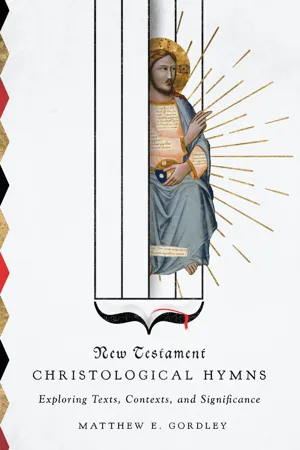
New Testament Christological Hymns
Exploring Texts, Contexts, and Significance
- 252 pages
- English
- ePUB (mobile friendly)
- Available on iOS & Android
About this book
We know that the earliest Christians sang hymns. Paul encourages believers to sing "psalms, hymns, and spiritual songs." And at the dawn of the second century the Roman official Pliny names a feature of Christian worship as "singing alternately a hymn to Christ as to God." But are some of these early Christian hymns preserved for us in the New Testament? Are they right before our eyes?New Testament scholars have long debated whether early Christian hymns appear in the New Testament. And where some see preformed hymns and liturgical elements embossed on the page, others see patches of rhetorically elevated prose from the author's hand.Matthew Gordley now reopens this fascinating question. He begins with a new look at hymns in the Greco-Roman and Jewish world of the early church. Might the didactic hymns of those cultural currents set a new starting point for talking about hymnic texts in the New Testament? If so, how should we detect these hymns? How might they function in the New Testament? And what might they tell us about early Christian worship?An outstanding feature of texts such as Philippians 2:6-11, Colossians 1:15-20, and John 1:1-17 is their christological character. And if these are indeed hymns, we encounter the reality that within the crucible of worship the deepest and most searching texts of the New Testament arose. New Testament Christological Hymns reopens an important line of investigation that will serve a new generation of students of the New Testament.
Frequently asked questions
- Essential is ideal for learners and professionals who enjoy exploring a wide range of subjects. Access the Essential Library with 800,000+ trusted titles and best-sellers across business, personal growth, and the humanities. Includes unlimited reading time and Standard Read Aloud voice.
- Complete: Perfect for advanced learners and researchers needing full, unrestricted access. Unlock 1.4M+ books across hundreds of subjects, including academic and specialized titles. The Complete Plan also includes advanced features like Premium Read Aloud and Research Assistant.
Please note we cannot support devices running on iOS 13 and Android 7 or earlier. Learn more about using the app.
Information
Notes
One - The Place of Hymns in the New Testament and in Scholarship
Table of contents
- Cover
- Title Page
- Dedication Page
- Contents
- Acknowledgments
- Abbreviations
- One - The Place of Hymns in the New Testament and in Scholarship
- Two - The Cultural Matrices of Early Christian Worship
- Three - The Philippian Hymn
- Four - The Colossian Hymn
- Five - The Prologue of the Gospel of John
- Six - A Wider Look
- Conclusion
- Bibliography
- Author Index
- Subject Index
- Scripture Index
- Notes
- About the Author
- More Titles from InterVarsity Press
- Copyright